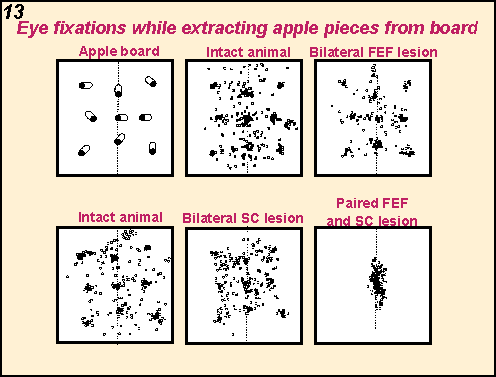The Neural
Control of Visually Guided Eye Movements
C. Cortical Mechanisms of Visually Guided Saccadic Eye Movements
 The
next question is what happens when both the frontal eye fields and the
superior colliculi are removed. This produced dramatic results as shown
in Figure 13. Monkeys were trained
to pick out apple pieces placed into slots of different orientations on
what we called an "apple board." This figure shows the fixations the monkey
made while performing this task repeatedly. Bilateral frontal eye field
(FEF) or bilateral superior colliculus (SC) lesions produced relatively
small deficits. However, when both structures were removed bilaterally,
there was a dramatic deficit: monkeys could no longer target the stimuli
with their eyes even though they continued to remove and eat the apple
pieces. Animals in which removal of these structures was complete, there
were practically no eye movements generated to visual targets. Thus
when the superior colliculus and the frontal eye fields are both removed,
visually guided eye movements are eliminated. This suggests that these
two structures are essential components for the generation of visually
guided eye-movements. The
next question is what happens when both the frontal eye fields and the
superior colliculi are removed. This produced dramatic results as shown
in Figure 13. Monkeys were trained
to pick out apple pieces placed into slots of different orientations on
what we called an "apple board." This figure shows the fixations the monkey
made while performing this task repeatedly. Bilateral frontal eye field
(FEF) or bilateral superior colliculus (SC) lesions produced relatively
small deficits. However, when both structures were removed bilaterally,
there was a dramatic deficit: monkeys could no longer target the stimuli
with their eyes even though they continued to remove and eat the apple
pieces. Animals in which removal of these structures was complete, there
were practically no eye movements generated to visual targets. Thus
when the superior colliculus and the frontal eye fields are both removed,
visually guided eye movements are eliminated. This suggests that these
two structures are essential components for the generation of visually
guided eye-movements.
|